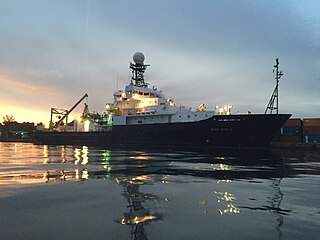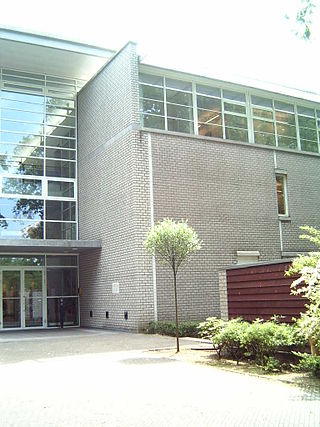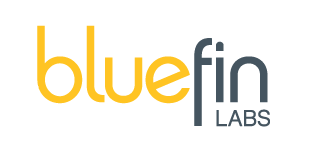Related Research Articles
In information theory, data compression, source coding, or bit-rate reduction is the process of encoding information using fewer bits than the original representation. Any particular compression is either lossy or lossless. Lossless compression reduces bits by identifying and eliminating statistical redundancy. No information is lost in lossless compression. Lossy compression reduces bits by removing unnecessary or less important information. Typically, a device that performs data compression is referred to as an encoder, and one that performs the reversal of the process (decompression) as a decoder.

MP3 is a coding format for digital audio developed largely by the Fraunhofer Society in Germany under the lead of Karlheinz Brandenburg. It was designed to greatly reduce the amount of data required to represent audio, yet still sound like a faithful reproduction of the original uncompressed audio to most listeners; for example, compared to CD-quality digital audio, MP3 compression can commonly achieve a 75–95% reduction in size, depending on the bit rate. In popular usage, MP3 often refers to files of sound or music recordings stored in the MP3 file format (.mp3) on consumer electronic devices.
Speech synthesis is the artificial production of human speech. A computer system used for this purpose is called a speech synthesizer, and can be implemented in software or hardware products. A text-to-speech (TTS) system converts normal language text into speech; other systems render symbolic linguistic representations like phonetic transcriptions into speech. The reverse process is speech recognition.

Digital audio is a representation of sound recorded in, or converted into, digital form. In digital audio, the sound wave of the audio signal is typically encoded as numerical samples in a continuous sequence. For example, in CD audio, samples are taken 44,100 times per second, each with 16-bit resolution. Digital audio is also the name for the entire technology of sound recording and reproduction using audio signals that have been encoded in digital form. Following significant advances in digital audio technology during the 1970s and 1980s, it gradually replaced analog audio technology in many areas of audio engineering, record production and telecommunications in the 1990s and 2000s.
Csound is a domain-specific computer programming language for audio programming. It is called Csound because it is written in C, as opposed to some of its predecessors.

A DNA microarray is a collection of microscopic DNA spots attached to a solid surface. Scientists use DNA microarrays to measure the expression levels of large numbers of genes simultaneously or to genotype multiple regions of a genome. Each DNA spot contains picomoles of a specific DNA sequence, known as probes. These can be a short section of a gene or other DNA element that are used to hybridize a cDNA or cRNA sample under high-stringency conditions. Probe-target hybridization is usually detected and quantified by detection of fluorophore-, silver-, or chemiluminescence-labeled targets to determine relative abundance of nucleic acid sequences in the target. The original nucleic acid arrays were macro arrays approximately 9 cm × 12 cm and the first computerized image based analysis was published in 1981. It was invented by Patrick O. Brown. An example of its application is in SNPs arrays for polymorphisms in cardiovascular diseases, cancer, pathogens and GWAS analysis. It is also used for the identification of structural variations and the measurement of gene expression.

William Daniel Hillis is an American inventor, entrepreneur, and computer scientist, who pioneered parallel computers and their use in artificial intelligence. He founded Thinking Machines Corporation, a parallel supercomputer manufacturer, and subsequently was Vice President of Research and Disney Fellow at Walt Disney Imagineering.

Computer Science and Artificial Intelligence Laboratory (CSAIL) is a research institute at the Massachusetts Institute of Technology (MIT) formed by the 2003 merger of the Laboratory for Computer Science (LCS) and the Artificial Intelligence Laboratory. Housed within the Ray and Maria Stata Center, CSAIL is the largest on-campus laboratory as measured by research scope and membership. It is part of the Schwarzman College of Computing but is also overseen by the MIT Vice President of Research.
MUSIC-N refers to a family of computer music programs and programming languages descended from or influenced by MUSIC, a program written by Max Mathews in 1957 at Bell Labs. MUSIC was the first computer program for generating digital audio waveforms through direct synthesis. It was one of the first programs for making music on a digital computer, and was certainly the first program to gain wide acceptance in the music research community as viable for that task. The world's first computer-controlled music was generated in Australia by programmer Geoff Hill on the CSIRAC computer which was designed and built by Trevor Pearcey and Maston Beard. However, CSIRAC produced sound by sending raw pulses to the speaker, it did not produce standard digital audio with PCM samples, like the MUSIC-series of programs.

IBM Research is the research and development division for IBM, an American multinational information technology company headquartered in Armonk, New York, with operations in over 170 countries. IBM Research is the largest industrial research organization in the world and has twelve labs on six continents.

RV Roger Revelle is a Thomas G. Thompson-class oceanographic research ship operated by Scripps Institution of Oceanography under charter agreement with Office of Naval Research as part of the University-National Oceanographic Laboratory System (UNOLS) fleet. The ship is named after Roger Randall Dougan Revelle, who was essential to the incorporation of Scripps into the University of California San Diego.
The Texas Advanced Computing Center (TACC) at the University of Texas at Austin, United States, is an advanced computing research center that is based on comprehensive advanced computing resources and supports services to researchers in Texas and across the U.S. The mission of TACC is to enable discoveries that advance science and society through the application of advanced computing technologies. Specializing in high-performance computing, scientific visualization, data analysis and storage systems, software, research and development, and portal interfaces, TACC deploys and operates advanced computational infrastructure to enable the research activities of faculty, staff, and students of UT Austin. TACC also provides consulting, technical documentation, and training to support researchers who use these resources. TACC staff members conduct research and development in applications and algorithms, computing systems design/architecture, and programming tools and environments.
Speechome in linguistics is different from other common biological -omes such as genome, proteome, and expressome in that it is not biological. However, speechome reflects the omics trend in biology and science in general.
Illumina, Inc. is an American biotechnology company, headquartered in San Diego, California. Incorporated on April 1, 1998, Illumina develops, manufactures, and markets integrated systems for the analysis of genetic variation and biological function. The company provides a line of products and services that serves the sequencing, genotyping and gene expression, and proteomics markets, and serves more than 155 countries.

The Max Planck Institute for Psycholinguistics is a research institute located on the campus of Radboud University Nijmegen in Nijmegen, Gelderland, the Netherlands. The institute was founded in 1980 by Pim Levelt, and the institute is dedicated exclusively to psycholinguistics. Notably, it is also one of the few institutes of the Max Planck Society situated outside Germany. According to the ranking of Web of World Research Centers, the Nijmegen-based institute ranks second among all Max Planck Institutes (MPI) in terms of visibility and eight in terms of size. Currently the institute employs approximately 235 people.
Laboratory Corporation of America Holdings (Labcorp), headquartered in Burlington, North Carolina, provides laboratory services used for diagnosis and healthcare decisions. It operates one of the largest clinical laboratory networks in the world and has operations in over 100 countries; although its operations are primarily in the U.S.

CTD stands for conductivity, temperature, and depth. A CTD instrument is an oceanography sonde used to measure the electrical conductivity, temperature, and pressure of seawater. The pressure is closely related to depth. Conductivity is used to determine salinity.

Bluefin Labs was a Cambridge, MA-based social TV analytics company that used publicly available social media commentary from Twitter, Facebook and blogs to measure viewer engagement with television shows and ads at scale – historically a costly and complex problem for TV and marketing industries to solve.

Deb Roy is a Canadian scientist, tenured professor at Massachusetts Institute of Technology (MIT), and the director of the MIT Center for Constructive Communication.
Victor Waito Zue is a Chinese American computer scientist and professor at Massachusetts Institute of Technology.
References
- ↑ "Deb Roy is currently CEO of Bluefin Labs"
- ↑ "The Power of Babble ", Wired, 2007, "MIT researcher Deb Roy is videotaping every waking minute of his infant son's first 3 years of life..."
- 1 2 3 4 Roy, Deb; et al. (2006). ""The Human Speechome Project"" (PDF). Archived from the original (PDF) on 2012-02-06. Retrieved 2008-01-03.
- 1 2 Wright, Sarah H. (2006). ""Media Lab project explores language acquisition"". MIT News Office. Retrieved 2008-01-03.
- ↑ "Watch language grow in the 'Baby Brother' house", 2006, New Scientist